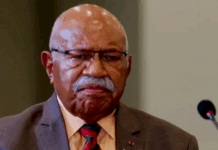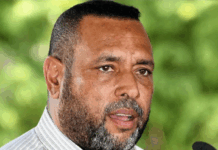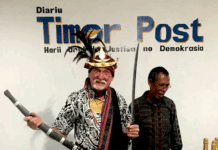Behind the Blockade, by Veronica Hatutasi. Boroko, Papua New Guinea: Word Publishing Company. 233 pages hardcover. ISBN 978-9980-89-024-5.
Reviewed by Anna Solomon
Behind the Blockade, by first time author Veronica Hatutasi, is a book recounting her personal experience in war-torn Bougainville between 1990 and 1994. It is the story of a mother who flees with her young family from their idyllic beach-front home in Toniva, to what she thought then was the safe haven of her family hamlet in Korikunu, Siwai district, in South Bougainville.
However, the turn of events beyond her control made them prisoners in their hamlet, cut off from the rest of the world and the daily struggles to survive behind the economic blockade imposed on Bougainville by the national government in Port Moresby.
They were then confronted with another crisis within the crisis, what the author describes as the Siwai sub-crisis.
When Veronica Hatutasi began the journey to Siwai for what was supposed to be just a short sojourn, little did she or other civilians know that what had started off as a disagreement on land compensation between the old executives of the Panguna Landowners Association and the younger well-educated new executive, would escalate into a civil war on Bougainville that would see the death and displacement of many innocent children, women and men.
Divided into four parts, the book, launched in Port Moresby on Friday evening, begins with life in Toniva from 1989 to 1990 where the author had spent 8 years with her family. In Part Two, the laid back lifestyle is not so idyllic any more as the daily gun battle between the Bougainville Revolutionary Army (BRA) and PNG Defence Force brings home the reality that their days in Toniva are numbered.
As trouble escalated and non-Bougainvilleans left, she knew it was a matter of time before she and her husband had to make a choice of whether to travel with her sister-in-law on the last boat out of the island or to make the long trip inland to her home in Siwai. She opted for the latter.
The story starts with enjoyment of the sea and sand through the innocent eyes of her son Jonath and his young friends during the halcyon days in Toniva. It ends with a more mature Jonath now living in Port Moresby, wondering if he will ever visit this favourite beach again.
Other books written
Books have already been written about the Bougainville crisis by academics, historians, political and defence analysts, overseas journalists and even some armchair experts, often focussing on the landowner issues and political decisions that led to the civil war and its aftermath.
However, there have also been publications that record personal experiences of people during that period.
A former PNGDF officer had his experiences during the crisis published, while a 2006 novel, Mr Pip, by New Zealand author Loyd Jones, fictionalised events of this dark period of Bougainville’s history. It was later made into a film with local actors and scenes shot on location.
However, Behind the Blockade is unique in that this is the first book by a Bougainvillean woman and a journalist who recounts her first-hand experience of life with her children during the civil war in her part of the island.
It is not an official record of events or atrocities that may have been committed on the island during the civil war and the author does not set out to make that point or get involved in the blame game.
Instead, the author draws from events in her part of Siwai, recorded in a diary she kept throughout the blockade to tell this story. An important part of this diary is the section on the Siwai crisis in which she describes the agony of seeing families being divided in their loyalty to the militants or to let common sense prevail and surrender their arms.
It tells of kidnappings of men, women and children. This was the turning point in Siwai, which would see the revival of the chief’s power and the people’s stand to put an end to the reign of terror and the suffering of innocent people at the hands of the BRA.
Winning hearts
The last part of the book comprises official events she covered as a journalist working in Port Moresby, of the peace process and the long road to winning the hearts and minds of the people and bringing normalcy to Bougainville.
The author acknowledges the role of the many strong and determined mothers of Bougainville, the peace advocates, who fearlessly entered the stronghold of the militants and started dialogue with their sons, brothers and male relatives to lay down arms and return home.
Some of them are still alive today, many more have passed on.
She also recounts the tale of loyal nurses at the Monoitu health centre and their dedication in tending to the sick and expectant mothers when medical supplies were practically non-existent.
She pays tribute to the local politicians and former senior public servants in Bougainville and at the national level who fearlessly stood up against the threats and intimidation of the militants. Again some died in their fight to save their people.
The book also describes the peacemaking efforts of the church, especially the lone Italian priest in Siwai, Fr Dario Monegatti, SVD, and his tireless trips between the militant factions as well his homilies during Sunday mass until his departure from Bougainville.
On the flip side, the civil war also caused divisions among the churches, with one faction of the BRA using their denomination to terrorise the other Christians.
Well-illustrated
Written in simple English, this book with pictures, will appeal to both young and old and especially those who have heard about the Bougainville crisis but were too young to understand its consequences.
It gives a glimpse of one family’s struggle and a mother’s determination to survive and bring her children out of the war-torn island. It shows a mother’s heartache in watching her children missing out on the simple pleasures of childhood they were used to while living in town.
It shows the important role of the extended family ties and how they rally around, during the time of need.
The book also talks about the people resorting to traditional medicines and appropriate technology when the store-bought medicines and food were no longer available.
The inclusion of the Bougainville chronology and a chronology of the peace process at the end of the book, will help the reader keep track of important historical dates from 1884 until the November 11th 2007 agreement with the national government to establish an autonomous government.
A must read for the mothers and fathers of PNG, Behind the Blockade offers a glimpse of the determination to overcome blockades in order to give innocent children another chance in life.
It also captures the beginnings of a healing process between the national government and people of Papua New Guinea, and the people of Bougainville.
Author Veronica Hatutasi is a respected senior journalist in Papua New Guinea. She is now the editor of Wantok Niuspepa, the weekly Tok Pisin paper where she started work as a displaced person from Bougainville in 1993. Ordering and other information about her book is available from the author.













































How do i get one of the coppies of that book
Contact the author: vhatutasi@wantok.com.pg
I look forward to reading this book. Just one point from your review: There was no 2007 agreement setting up the autonomous government for Bougainville as the first ABG had already been sworn in in 2005. Not sure if this error if from the book or the review. Much writing on Bougainville while insightful tends to contain simple factual errors due to a lack of fact checking or knowledgeable editing.
Comments are closed.